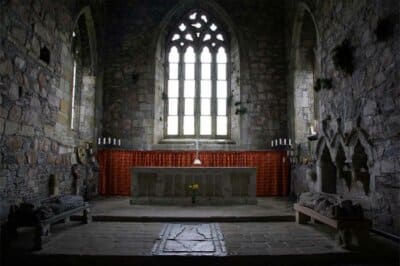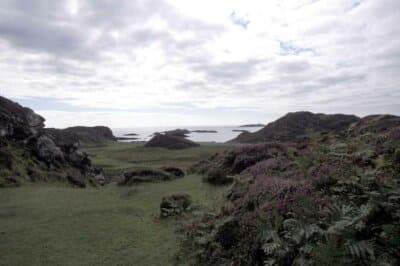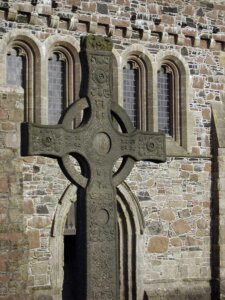St Columba is the man often regarded as the father of Christianity in Scotland. He was born in County Donegal in Ireland in 521, and travelled to Iona in 563.
The first tentative step in the establishment of Christian worship in Scotland was more than a spiritual journey; it had political, social and economic elements.

It was a process, which may have begun with St Ninian in south-west Scotland around the end of the fourth century but, thanks to St Columba, had its strongest roots on the Isle of Iona.
Although little is known of his early life, respected archaeologist and historian Dr Anna Ritchie, writing for Historic Scotland, says it was the custom in Ireland to send sons to be fostered by “worthy individuals.”
We do know he was born, of royal blood, in County Donegal in the north west of Ireland in 521.
For Columba, this meant living with Cruithnechan, a local priest who gave the young boy his early training for the church.
Later as a deacon, he studied under Bishop Finnen probably at the monastery of Clonard in county Meath.
st Columba & Adomnán the ninth Abbott of Iona
Columba was over forty when he left Ireland, “wishing to be a pilgrim for Christ” according to Adomnán, ninth Abbott of Iona from 679 – 704 and author of the Life of Columba.

However, the ‘traditional’ version of the story of Columba’s hasty departure from Ireland is quite different.
He left, it is said, as a punishment for his role in the bloody battle of Cuildreimhne in which the high king was defeated.
Whatever the reason for leaving his homeland, Columba and twelve followers arrived on Iona in 563,
He landed not in the Scotland we understand today but in the Gaelic kingdom of Dalriada which occupied much of modern Argyll and parts of Northern Ireland.
There he founded a monastery, which became the mother church of Celtic Christianity in Scotland.
Columba’s humble church on Iona became the first of a network of monasteries established around the country in his name.
On the mainland to the north were the Picts, who became the focus of much of his life’s work, and to the south the Britons.
So the Scotland that Columba came to was not a single entity but a patchwork of competing kingdoms.
Related stories
- Scotland’s earliest monarchs
- Dunkeld Cathedral by the River Tay
- Dumbarton Castle fortress of the Britons
a description of St Columba’s monastery
However, we can turn again to Adomnán for an indication of what Columba’s monastery was like. While he hasn’t left a comprehensive picture of the building he mentions enough detail to allow a mental picture of what life was like.

He refers to a church with a side-chamber or chapel, sleeping cubicles for the monks and a communal space which could have been used for the preparation and consumption of food.
It seems Columba had two ‘buildings’ for himself, the first “for his couch, the bare rock, and for his pillow a stone.”
The second was his writing space. All this was enclosed by a vallum or earthen rampart, traces of which are still visible today, particularly if seen from the air.
St Columba was a man of letters, credited with transcribing over 300 manuscripts with his own hand.
None have survived although the Cathach of Columba, a vellum Psalte, one of the earliest illuminated manuscripts was initially thought to be the work of the saint.
Currently housed in the Royal Irish Academy in Dublin most scholars now date it to the seventh century (c 610-620).
St Columba & The Book of Kells
The Book of Kells, which takes its name from the abbey of County Meath, is now on display at Trinity College Dublin. It is without a doubt the great surviving masterpiece of illuminated art.
Also known as the Book of Columba it includes four Gospels of the New Testament written in Latin.
Again tradition has linked the writing of the Book of Kells to Columba and while most experts agree that it was scribed on Iona it was done so after his death.
An Iona Chronicle is known to have existed; indeed some scholars argue that there were two copies, which may have found their way for reasons of safety, to Armagh and Clonard in Northern Ireland.
Although sadly they have been lost, part of the original manuscript was copied into the Annals of Ulster.
The text allows some understanding of political events in Dalriada and further afield in Pictland. It also records some information relating to the abbots of Iona.
The Annals cover a period from around the early seventh century to about 740.
The latter date is much easier to ascertain because the writer had provided some information about journeys from Iona to Ireland.
However, after 740 the journey direction altered becoming journeys from Ireland to Iona; a fairly positive indication of a change of writing location.
St Columba & The Venerable Bede
One valuable source of information relating to Columba and his work with the Picts came from the Venerable Bede an eighth century monk, historian and writer from Jarrow in the north of England.
Bede was quite clear that St Columba had a mission to convert the Picts to Christianity. His Ecclesiastical History of the English People completed in 731 is the single most valuable source of early history.
It says, “In the year of our Lord 565 (note the difference in date) there came from Ireland a priest and abbot to preach the word of God to the provinces of the northern Picts…”
Other references to Columba’s work among the Picts, who lived along the River Tay, can be found in a poem, The Elegy of Colum Cille, written shortly after Columba’s death by Dallán Forgaill.
It says, “His [Columba’s] blessing turned them, the mouths of the fierce ones who lived on the Tay, to the will of the king,” a line which Anna Ritchie interprets as an implication that Columba had the authority from the Pictish king to convert his people.
Adomnán wrote that Columba’s final day, 9 June 597, was spent writing on the Torr An Alba (Hill of Scotland), a rock that stands in front of the present Abbey.
Returning to the church he gave a last blessing to his monks before dying in prayer at the altar.
Historic Environment Scotland: Iona Abbey visitor information
- For more information and help planning your visit, go to the official Iona Abbey website.